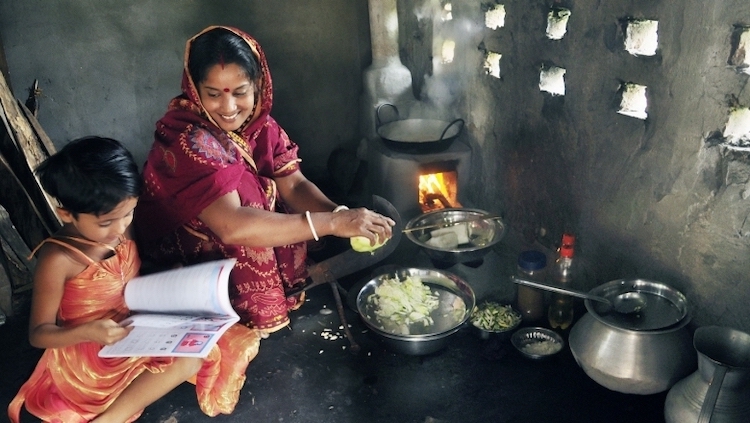By Kalinga Seneviratne
SYDNEY (IDN) — In the Asia-Pacific region which is home to about 60 percent of the global population, some 1.6 billion people primarily rely on open fires or simple stoves fueled by kerosene, coal, or biomass such as wood, dung and agricultural residues for their daily cooking needs, that impacts on climatic change and health hazards. GERMAN | JAPANESE | THAI
“Burning biomass in these inefficient stoves contributes to atmospheric warming and forest depletion while inhaling the fine particulates emitted causes a range of serious health impacts,” says Olivia Baldy, Energy Access Consultant, at the Bangkok-based UNESCAP (United Nations Economic and Social Commission for Asia and the Pacific). “In 2016, poor indoor air quality contributed to an estimated 2.2 million premature deaths in Asia and the Pacific,” she adds.
As the region recovers from the economic devastation of the Covid-19 pandemic, making clean cooking fuels affordable for low-income families will be a great challenge to providing energy access, which is crucial for the achievement of Sustainable Development Goal 7.
With rural populations and the urban poor increasingly getting access to the electricity grid, and solar power technology providing cooking fuel alternatives, the challenge is for the governments and the non-profit sector to make available the financing to assist the poor to cut both their cooking fuel costs and the carbon footprint.
While cleaner cooking solutions have the potential to generate a variety of social, economic, and environmental benefits, yet, the clean cooking sector remains hugely underfinanced.
An ‘Energy Finance Landscape 2020’ report By the Climate Policy Initiative CPI), argues that the Covid-19 pandemic should be seen as a wake-up call to accelerate attempts to realized SDG 7 that calls for access to affordable, reliable, sustainable, and modern energy for all by 2030.
“The COVID-19 pandemic has highlighted the severe implications that a lack of reliable energy access can have on healthcare systems, water and sanitation services, clean cooking, and communication and IT services,” the report notes, adding that, despite significant advances over the last decade, electricity and clean cooking access continue to elude more than 789 million across the region.
The CPI report points out that except for Bangladesh, investments in giving access to the poor for clean cooking technology are lacking in the region and they argue that “green recovery” is crucial to developing sustainable economic recovery models.
With the upcoming negotiations under the ‘Paris Agreement’ on national carbon markets, this could be a source of funding for providing clean cooking alternatives for the poor using solar power and “green” electricity. According to the CPI report, only $ 21 million of investments under this facility is estimated to have taken place in 2018.
For rural households connected to mini-grid and solar home systems, the cost of cooking with electricity is now within the cost-competitiveness range of other cooking alternatives, according to a World Future Council and Hivos report in 2019. In addition to the decreasing cost of electric cooking devices, potential synergies between electrification and clean cooking are significant and yet not fully explored, it notes. But, adds that, for example, Nepal’s Ministry of Energy, Water Resource and Irrigation has stated last year that the government plan to reach the goal of an “electric stove in every house” through strengthening the country’s distribution networks, discussing the possible adjusting of electricity tariffs to favour electric cooking.
Bangladesh imports about 60 percent of its LPG needs and offers significant subsidies for LPG cylinders and fuel. CPI report points out that almost 74 percent of the rural population relies primarily on biomass fuels for cooking, which includes straw, husk, bran, jute stick, wood, and bamboo; while over 95 percent of the population and more than 80 percent of the rural populace in the country has electricity access which can be leveraged to establish a supply chain for efficient electricity-based cooking solutions in the most remote areas.
Between 2013-2017 through funding from a World Bank program, the Bangladesh government has helped poor households to install Improved Cookstoves (ICS) in 1 million households and it was expected to increase to 5 million by the end of 2021. CPI believes that there is a need to steadily redesign the existing policy and financing framework if Bangladesh is to achieve zero biomass use by 2030.
India’s ‘Surya Project’ is aiming to steadily replace the highly polluting cookstoves used in India’s rural households with clean energy stoves with funding sourced from carbon offsetting programs. In its first phase, Project Surya will target three rural areas in the Himalayas, Indo-Gangetic plains, Andra region in South India to enable 5,000 households in each region to switch to cleaner-burning technologies such as solar cookers and other efficient stove technologies.
They are introducing parabolic solar dish cookers of about 1.4 m diameter popularly referred to as SK14 and cost about $100. They are advertised as able to cook rice for a family of up to ten people in about 30 minutes. They are also using the mobile phone to measure climatic mitigation and health outcomes.
They are working with partners at the Center for Embedded Network Sensing at UCLA and Nexleaf Analysis in the U.S, to bringing together climate scientists, epidemiologists, computer scientists, energy technologists, economists, and rural economic development experts, to find solutions to three of the most pressing challenges facing Asia today – climate change, public health, and economic development.
“While more efficient technologies greatly reduce the costs of cooking, in many cases, consumers cannot afford the upfront investment needed to switch to cleaner, but often more expensive, alternatives. Amid the crisis induced by the COVID-19 pandemic, affordability is increasingly challenging, with many households backsliding into poverty” warns Baldy in an article published by UNESCAP monthly Newsletter. “This means that, without financial support, more low-income households may not be able to pay for clean cooking solutions”. [IDN-InDepthNews — 07 August 2021]
Photo: Ms. Shefali Ghosh from Savar, near Dhaka, teaches her daugher in the kitchen. Credit: The World Bank




